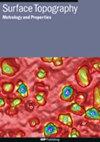Study on the mixed lubrication of rough planar extrusion considering surface texture
IF 2
3区 材料科学
Q2 ENGINEERING, MECHANICAL
引用次数: 0
Abstract
Surface texture plays a crucial role in fluid dynamic lubrication. The non-Newtonian thermal elastohydrodynamic lubrication problem involving rough surfaces with texture has not been investigated to date. In this paper, a model for non-Newtonian thermal elastohydrodynamic lubrication incorporating rough surfaces and texture morphology is developed, focusing on the problem of mixed lubrication in planar extrusion with texture. The model builds upon the Reynolds equation with flow factor introduced. It considers the effects of rough surface texture, thermal effects, and non-Newtonian effects. The Reynolds equation is numerically solved using the Semi-System method to calculate the oil film pressure in full film region and contact pressure in dry contact area. The DC-FFT algorithm is employed to calculate surface elastic deformation. Comparing the calculated friction coefficient of the present model with the measured values in literature experiments, the average error is only 6.94%. Furthermore, the study investigates the effects of texture, temperature, and non-Newtonian on interfacial lubrication performance under mixed lubrication conditions. It’s found that compared to untextured surface, the average film thickness of textured surface increased by a maximum of 10.8%, and the friction coefficient decreased by a maximum of 67.4%; Compared to Newtonian fluids, shear thinning fluids reduce temperature by 0.18%, and shear thickening fluids are more conducive to improving mixed lubrication performance. A stepped pit texture is designed based on the dynamic pressure mechanism of the texture, indicating that the circular stepped pit texture has the best load-bearing capacity improvement.考虑表面纹理的粗糙平面挤压混合润滑研究
表面纹理在流体动力润滑中起着至关重要的作用。迄今为止,涉及粗糙表面纹理的非牛顿热弹流体动力润滑问题尚未得到研究。本文建立了一个包含粗糙表面和纹理形态的非牛顿热弹流体动力润滑模型,重点研究了带有纹理的平面挤压中的混合润滑问题。该模型以雷诺方程为基础,并引入了流动因子。它考虑了粗糙表面纹理、热效应和非牛顿效应的影响。使用半系统法对雷诺方程进行数值求解,以计算全油膜区域的油膜压力和干接触区域的接触压力。采用 DC-FFT 算法计算表面弹性变形。将本模型计算出的摩擦系数与文献实验中的测量值进行比较,平均误差仅为 6.94%。此外,研究还探讨了混合润滑条件下质地、温度和非牛顿对界面润滑性能的影响。研究发现,与无纹理表面相比,有纹理表面的平均膜厚最大增加了 10.8%,摩擦系数最大降低了 67.4%;与牛顿流体相比,剪切稀化流体的温度降低了 0.18%,剪切增稠流体更有利于改善混合润滑性能。根据阶梯坑纹理的动压机理设计了一种阶梯坑纹理,表明圆形阶梯坑纹理的承载能力改善效果最好。
本文章由计算机程序翻译,如有差异,请以英文原文为准。
求助全文
约1分钟内获得全文
求助全文
来源期刊

Surface Topography: Metrology and Properties
Materials Science-Materials Chemistry
CiteScore
4.10
自引率
22.20%
发文量
183
期刊介绍:
An international forum for academics, industrialists and engineers to publish the latest research in surface topography measurement and characterisation, instrumentation development and the properties of surfaces.
 求助内容:
求助内容: 应助结果提醒方式:
应助结果提醒方式:


